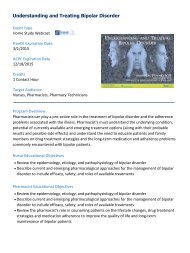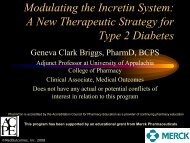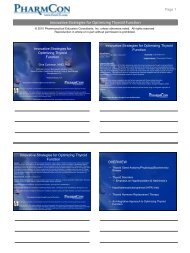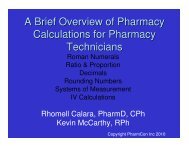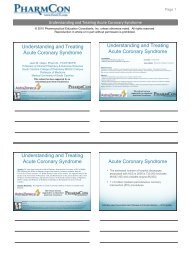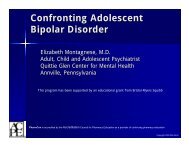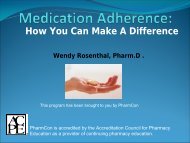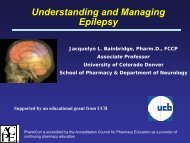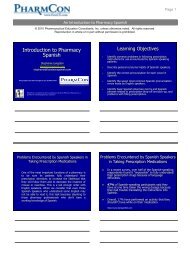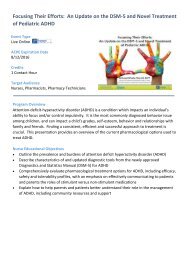Thyroid Monograph - FreeCE
Thyroid Monograph - FreeCE
Thyroid Monograph - FreeCE
Create successful ePaper yourself
Turn your PDF publications into a flip-book with our unique Google optimized e-Paper software.
iodide (Lugol solution) contains 8 mg of iodide per drop, and is used for the<br />
treatment of thyroid storm for 10 to 14 days prior to thyroidectomy.<br />
4. Beta-adrenergic receptor blockers<br />
Beta blockers help to promptly alleviate the sympathomimetic manifestations of<br />
hyperthyroidism (eg, palpitations, anxiety, tremors, and heat intolerance)<br />
regardless of its underlying cause. In patients with cardiac arrhythmias like sinus<br />
tachycardia or atrial fibrillation with a rapid ventricular response rate, beta<br />
blockers can function to control the heart rate. Propanolol, a nonselective beta<br />
blocker, is preferred because of its direct effect on hypermetabolism and is most<br />
commonly used, although other beta blockers can be given. 23 Propanolol also<br />
partially inhibits conversion of T4 to T3 in the peripheral tissues. 4<br />
may be the only treatment required in patients with transient forms of<br />
hyperthyroidism, however, in patients with more sustained forms of<br />
Beta blockers<br />
hyperthyroidism (ie, Graves’ disease, toxic nodular goiter), definitive treatment is<br />
10, 20, 21, 24<br />
necessary.<br />
Propanolol dose can start at 20 to 40 mg every 8 hours and be increased<br />
progressively up to a maximum daily dose of 240 mg until symptoms are<br />
controlled. Longer-acting beta blockers such as metoprolol and atenolol can also<br />
be used. In cases where a short-acting parenteral agent is needed, Esmolol can<br />
be administered. Beta blockers should be used with caution in patients with a<br />
history of heart disease, obstructive pulmonary disease, asthma, or Raynaud’s<br />
phenomenon.<br />
5. Radioactive iodine therapy<br />
Radioactive iodine causes selective uptake and concentration in thyrocytes.<br />
Following oral administration, it destroys thyroid tissue, thereby controlling<br />
hyperthyroidism effectively. This is the treatment of choice for the majority of<br />
patients with Graves’ disease and toxic nodular goiter. High dose radioactive<br />
iodine therapy is recommended in elderly patients, those with preexisting cardiac<br />
disease, and patients with toxic nodular goiter or toxic adenomas. 25<br />
Its main adverse effect is the development of postablative hypothyroidism, which<br />
is more commonly seen in patients with Graves’ disease. Lifelong monitoring of<br />
thyroid hormone levels is necessary because patients develop this complication<br />
at a rate of 3% annually. Another side effect is the transient worsening of<br />
hyperthyroidism during the first month of treatment due to radiation thyroiditis.<br />
Opthalmopathy may develop or exacerbate in 15 percent of patients with Graves’<br />
26, 27<br />
disease, especially in those who smoke cigarettes. Lower dose radioactive<br />
iodine or prednisone can be used in those patients to reduce the risk of<br />
ophthalmopathy. 28<br />
Torio-<strong>Thyroid</strong> Page 8



